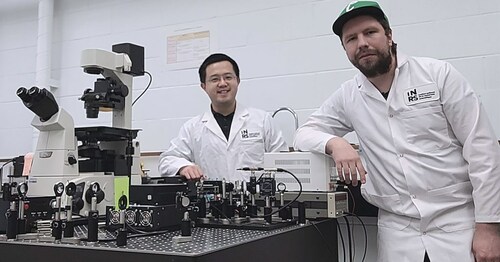
INRS releases camera with multiple applications
by CM staff
The technology is patented and the team is currently seeking collaborations to commercialize it.

Professor Jinyang Liang and doctoral student Patrick Kilcullen in their laboratory at the Énergie Matériaux Télécommunications Research Centre of the INRS. (Photo: CNW Group/Institut National de la recherche scientifique (INRS))
VARENNES — In their laboratory at the Énergie Matériaux Télécommunications Research Centre of the Institut national de la recherche scientifique (INRS), Professor Jinyang Liang and his colleagues are developing a high-speed single-pixel camera. This device, called single-pixel imaging accelerated via swept aggregate patterns (SPI-ASAP) is capable of streaming video at 12,000 frames per second using light modulation.
“This new camera is an innovative prototype with potential benefits for the photonics industry in Quebec and the rest of Canada,” says Dr. Liang.
Professor Jinyang Liang has focused his research on laser modulation techniques in new optical imaging devices. Single-pixel imaging (SPI) has emerged as a technique using light modulation and a single-point detector instead of a two-dimensional sensor. However, most SPI systems are limited by the sole use of digital micromirror devices (DMDs) which means that the speed at which the single-pixel camera can record images is only a few tens of hertz.
Other methods use fast-moving physical encoding masks for light modulation. Although fast, these masks also fix the resolution, making such systems inflexible to be adapted to different experimental parameters.
In contrast to these approaches, the new camera developed by scientists at INRS combines a digital micromirror device with laser scanning for fast and reconfigurable pattern projection. This allows the system to operate at different spatial resolutions, as well as at different imaging speeds and modes. As a result, it is capable of streaming real-time video at 100 frames per second (fps), and up to 12,000 fps offline.
“The ability to image in real-time at 100 fps surpasses existing technologies and sheds light on many industrial applications where on-site analysis and online feedback are needed,” said Patrick Kilcullen, first author of the paper and a doctoral student at INRS.
The team, consisting of PhD student Patrick Kilcullen and professors Tsuneyuki Ozaki and Jinyang Liang, has patented the technique and is currently seeking collaborations to commercialize it.